


This article highlights the essential signs of angina that elderly patients should be aware of, aiming to foster timely medical intervention. It gently points out that symptoms like chest pain, shortness of breath, fatigue, nausea, and even atypical signs such as radiating pain or anxiety could indicate angina. Recognizing these symptoms early is crucial, especially for older adults who may be at a heightened risk for coronary artery disease.
Have you or someone you care about experienced any of these symptoms? Understanding these signs can help you take proactive steps towards your health. It’s important to remember that you are not alone in this journey; many people share similar concerns. Early detection can significantly reduce the risk of serious complications, allowing for better management of your health.
If you notice any of these symptoms, please reach out to your healthcare provider. They are there to support you and can provide the necessary care to ensure your well-being. Remember, taking action is a sign of strength, and seeking help can make all the difference in your health journey.
Recognizing the signs of angina is crucial, especially for the elderly, as timely intervention can be the difference between life and death. Angina, often a precursor to more severe heart conditions, manifests in various ways, from chest discomfort to atypical symptoms like fatigue and shortness of breath. As caregivers and loved ones, understanding these signs can empower proactive health management. But what happens when these symptoms are subtle or misinterpreted?
This article delves into the key indicators of angina that every elderly patient should be aware of, highlighting the importance of vigilance and prompt action in safeguarding heart health. Remember, staying informed and attentive can make all the difference in ensuring a healthier future.
At Amavita Heart and Vascular Health, we understand how important it is to recognize the signs of angina early, especially for our elderly patients. Angina, a common indicator of coronary artery disease (CAD), can show itself in various forms, such as chest pain, pressure, or discomfort that may radiate to the jaw, neck, or back. It's essential to note that women might experience atypical symptoms like nausea or shortness of breath, which can make timely diagnosis more challenging.
Early detection is vital. It allows for prompt treatment, significantly reducing the risk of serious complications, including heart attacks. Did you know that nearly 82% of CAD deaths occur in individuals over 65? This statistic highlights the urgency of recognizing the signs of angina as warning signs. Furthermore, studies reveal that almost two-thirds of newly diagnosed patients do not have significant coronary obstructions. This underscores the need for awareness and proactive healthcare interventions.
Patients and caregivers, it is crucial to be informed about both standard and unusual manifestations of chest pain. This knowledge ensures that you can seek medical attention promptly when necessary. Effective management of angina in older populations often involves lifestyle changes, medication, and consistent monitoring. By prioritizing early detection and intervention, we can significantly improve the chances of preventing heart attacks, ultimately enhancing the quality of life for those affected.
Remember, you are not alone in this journey. We are here to support you every step of the way.
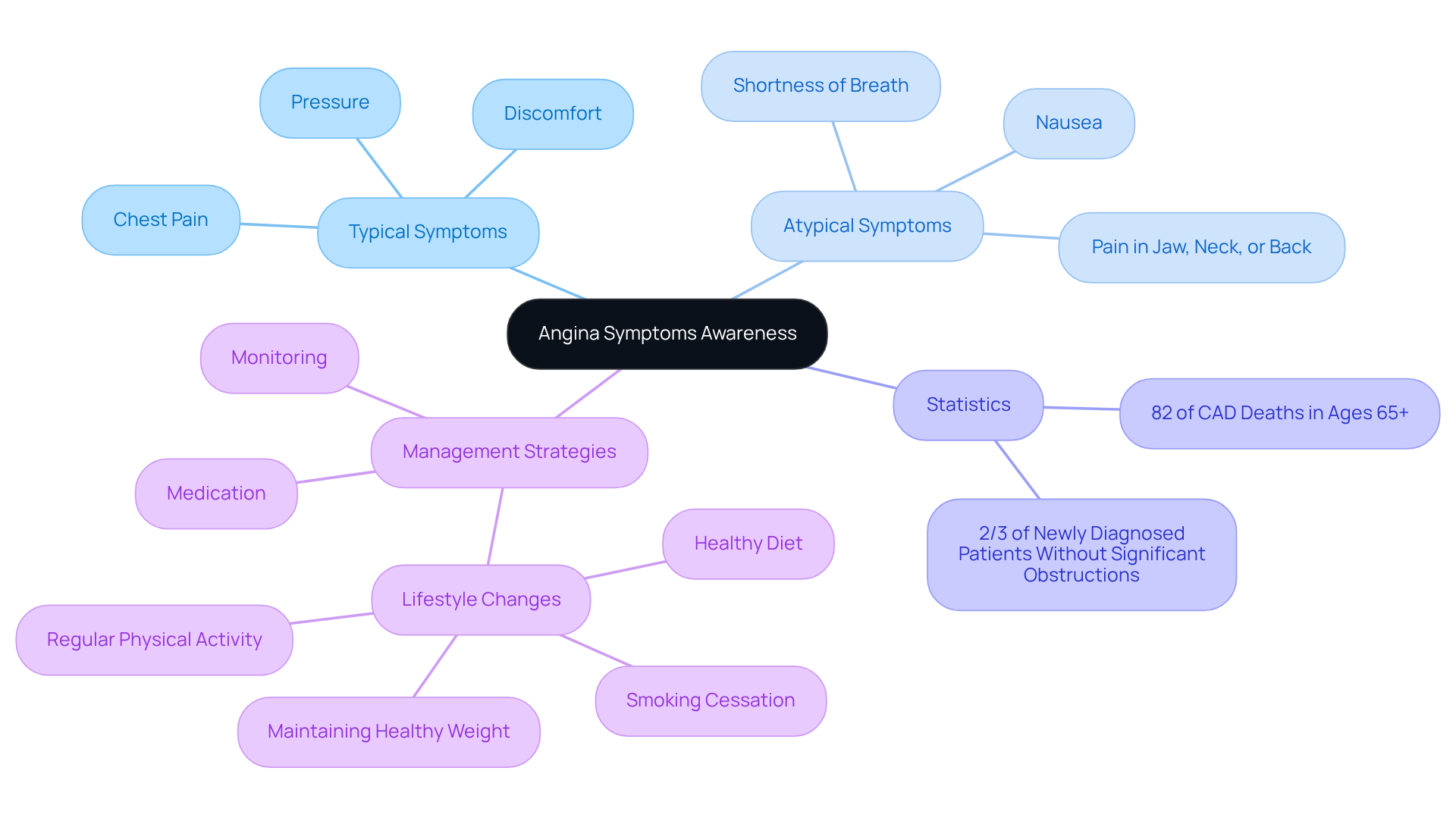
Chest pain is often described as a feeling of pressure, squeezing, or tightness in the chest. However, in elderly patients, this discomfort can present differently. It may be less intense or, in some cases, even absent altogether. This unusual manifestation can complicate diagnosis, as many older adults might not express typical symptoms.
It is essential for caregivers to stay observant of any changes in behavior or activity levels that could indicate underlying discomfort. Recent studies suggest that older adults may experience chest pain during physical activity or emotional strain, but these signs can be quite subtle. Identifying the signs of angina promptly is crucial, as untreated chest pain can lead to more serious cardiovascular issues.
Therefore, caregivers should prioritize monitoring their loved ones for any signs of angina, even if they do not explicitly mention chest pain. Your vigilance can make a significant difference in their health and well-being.
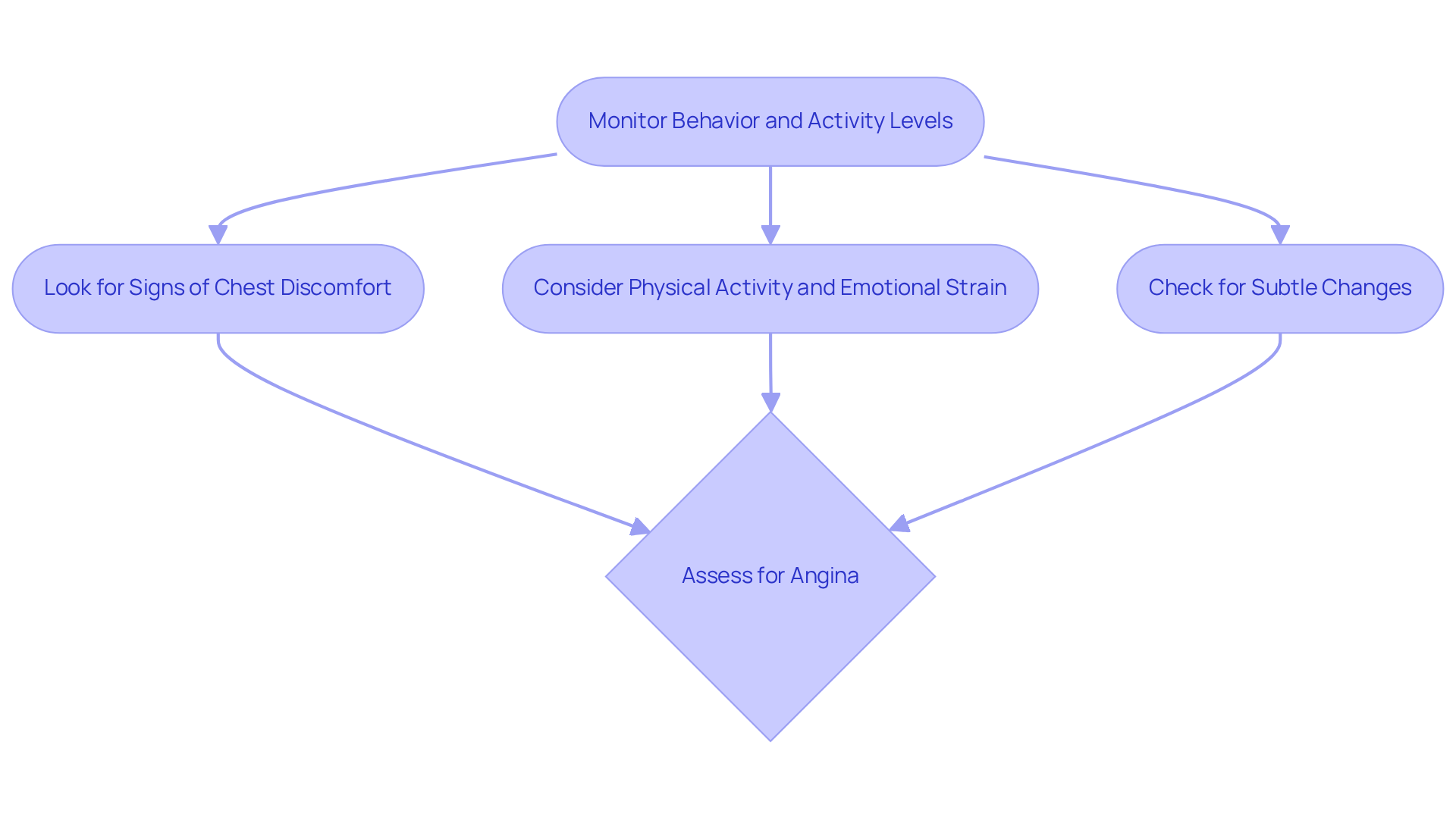
Shortness of breath, or dyspnea, is an important signal and can be considered one of the signs of angina, sometimes even occurring at rest. For older individuals, this symptom can be particularly worrying, as it may indicate that the heart is not receiving enough oxygen. In fact, research shows that dyspnea is common among older adults with coronary artery disease, with studies revealing that up to 50% of these individuals experience significant breathlessness during their daily activities.
As caregivers, it is essential to be attentive to any increase in breathlessness, especially during routine tasks. This change may warrant further evaluation by a healthcare provider. In addition to this, experts in pulmonology remind us that dyspnea not only diminishes quality of life but can also worsen existing heart conditions, creating a cycle of declining health.
Understanding how dyspnea impacts cardiac well-being is crucial for timely intervention and management. It serves as a vital warning sign of potential heart issues in the elderly, and recognizing the signs of angina can lead to better care and support. If you or a loved one is experiencing these symptoms, please do not hesitate to reach out for help. You are not alone, and there are resources available to assist you.
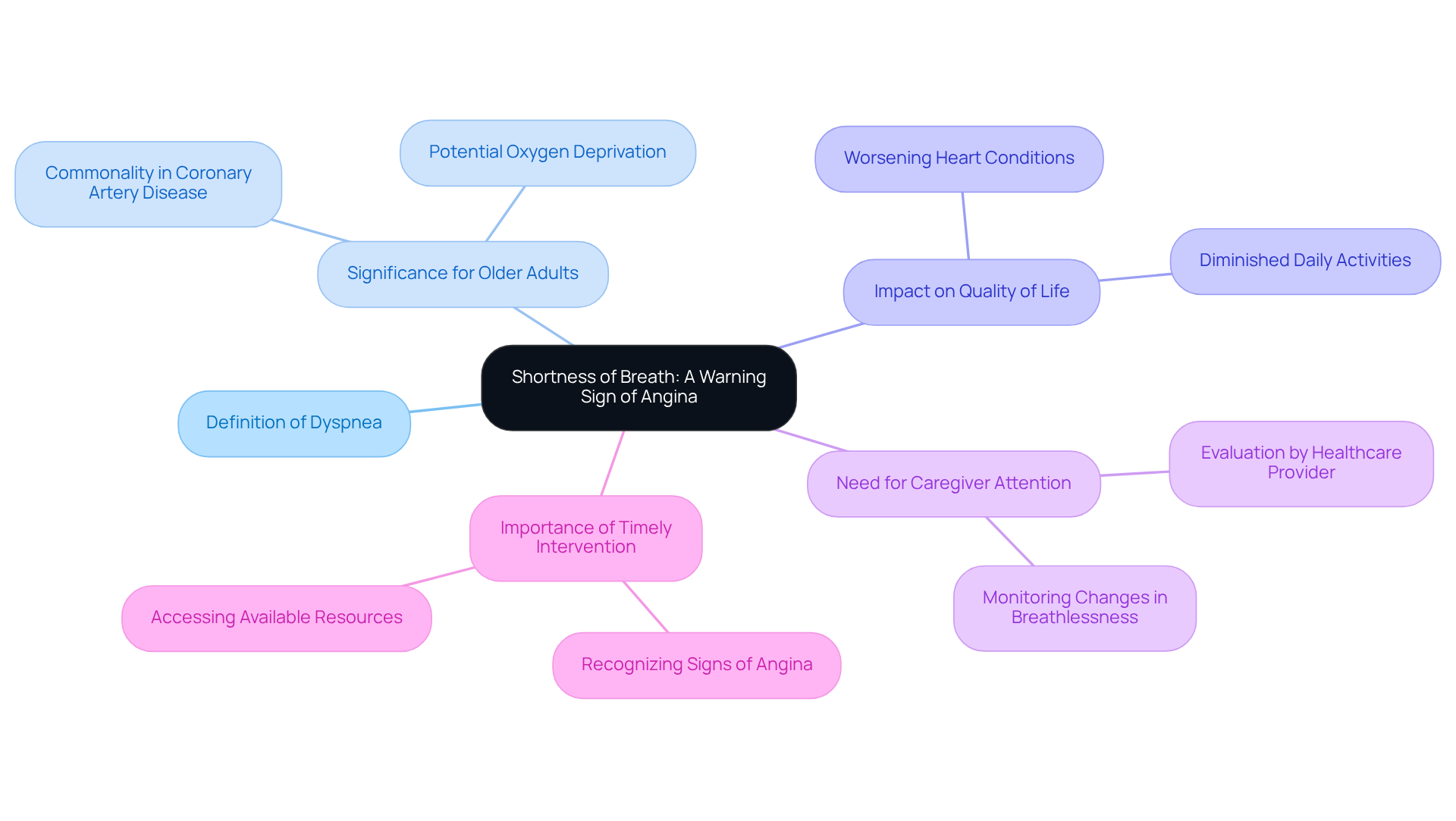
Fatigue is often overlooked as just a sign of aging or stress, but it can be a vital indicator of signs of angina, particularly in elderly patients. This type of fatigue frequently lingers even with rest and may come with a general sense of malaise. Recent studies have shown that chronic fatigue can point to underlying heart issues, such as coronary artery disease, heart failure, or valve problems. Cardiologists have observed that it may reflect the heart's struggle to pump efficiently, which can lead to a reduced oxygen supply throughout the body.
At Amavita Heart and Vascular Health, we offer comprehensive cardiac evaluations tailored to identify the specific causes of fatigue. This allows us to develop personalized treatment plans aimed at improving heart function and restoring energy levels. Caregivers should be vigilant for any sudden changes in energy levels or increased fatigue, as these may signal the need for prompt medical assessment. Recognizing these subtle signs of angina is crucial; timely intervention can greatly enhance outcomes for individuals with cardiovascular conditions.
Our innovative AI-powered diagnostic technology improves early detection, offering real-time guidance for accurate imaging and generating reports on heart structure and function within minutes. Experts emphasize the importance of understanding the link between fatigue and cardiovascular health, especially for elderly individuals who may find it difficult to express their concerns. By prioritizing awareness of fatigue as a potential warning sign, caregivers can play a significant role in facilitating early detection and treatment of heart-related issues.

Nausea and excessive perspiration can be concerning signs that sometimes accompany angina, often leading to confusion with gastrointestinal issues, especially in older individuals. Have you ever wondered how these symptoms might mislead someone? Research indicates that these signs can be particularly deceptive, as they may not always present alongside the typical cardiac warning signs like chest pain. Cardiologists stress the importance of recognizing these atypical presentations, as it is vital for timely intervention.
For example, consider the case of an elderly woman who experienced chest pain, nausea, and heavy sweating. This situation underscores the necessity for immediate medical evaluation. At Amavita Heart and Vascular Health, our specialists are dedicated to utilizing advanced diagnostic imaging to identify potential blockages and arrhythmias. This ensures that individuals receive expert diagnoses and minimally invasive treatments, such as cardiac catheterization and stent placement.
Caregivers should remain watchful for episodes of nausea or sweating that occur alongside other warning signs, such as shortness of breath or chest discomfort. Misdiagnosis of chest pain symptoms in seniors is a significant concern, as it can lead to delays in critical treatment. Therefore, any sudden onset of nausea or heavy sweating should prompt immediate medical evaluation, as these may be regarded as signs of angina indicating a serious cardiac event requiring urgent care.
Our innovative AI-powered diagnostic technology, part of the Amavita CardioElite™ program, enhances early detection and healthcare outcomes, ensuring that elderly individuals receive the best possible care. Remember, you are not alone in this journey; we are here to support you and your loved ones every step of the way.
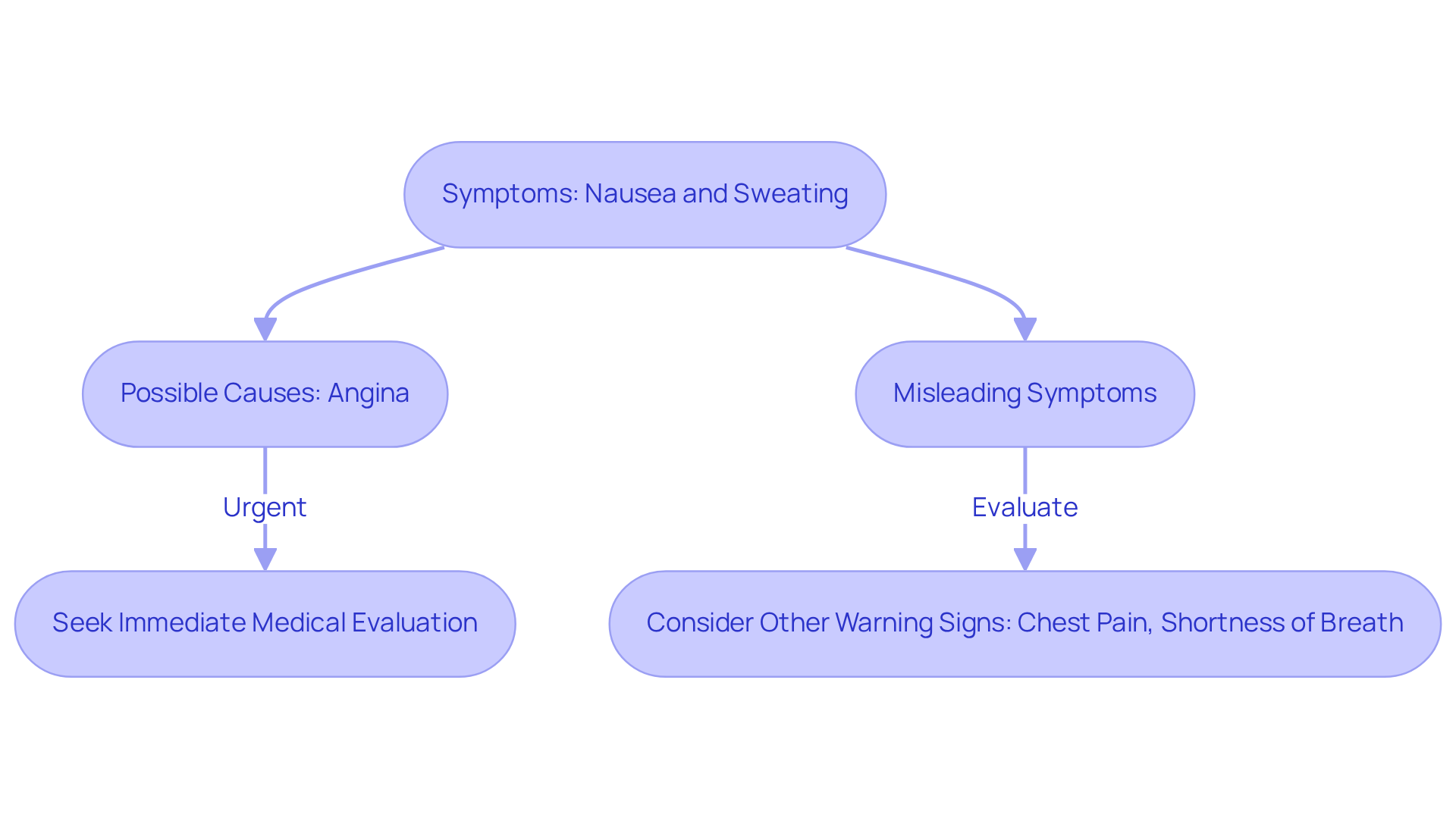
Angina pain often radiates beyond the chest, showing up in the arms, neck, jaw, or back. This radiating discomfort is particularly important for older individuals, as they may not exhibit the typical chest pain associated with heart issues. Research indicates that atypical presentations are common among older adults, making it essential for caregivers to be trained in recognizing these patterns. For instance, discomfort in the jaw or back can easily be misattributed to other conditions, which may delay necessary medical intervention.
Cardiologists stress that being aware of signs of angina and other non-chest pain indicators can significantly enhance the urgency of care, ultimately improving patient outcomes. Recognizing these signs is vital; timely intervention can prevent complications associated with untreated angina. Notably, over 20% of heart attacks are classified as 'silent,' underscoring the importance of vigilance in identifying atypical symptoms.
Risk factors such as family history, high blood pressure, high cholesterol, and diabetes further highlight the need for caregivers to be proactive in monitoring for these signs. At Amavita Heart and Vascular Health®, we promote thorough cardiac evaluations that integrate advanced risk assessment tools with individualized interventions tailored to each person's specific condition and lifestyle. Our innovative AI-powered diagnostic technology, including the amavita CardioElite™ program, enhances early detection and supports informed decision-making, ensuring that elderly individuals receive the best possible care.
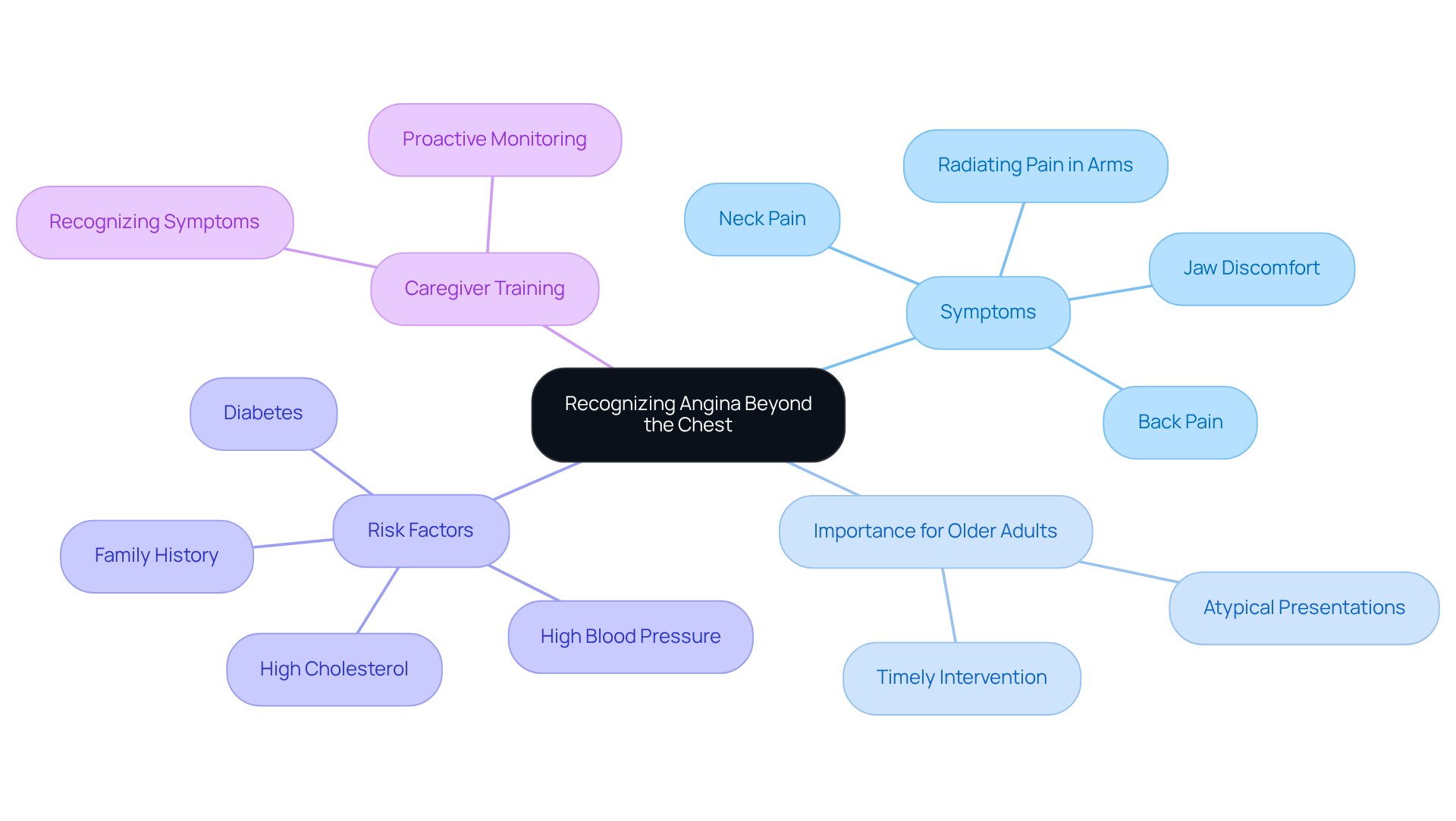
Anxiety and panic attacks can present signs that closely resemble those of angina, including chest pain and shortness of breath. This overlap of indicators presents a considerable risk of misdiagnosis or postponed treatment, especially in older patients. Have you ever wondered if your symptoms might be more than just anxiety? Research indicates that many older adults may experience anxiety symptoms that mimic cardiac issues, complicating the clinical picture. In fact, studies show that a substantial percentage of emergency department visits for chest pain are linked to anxiety disorders rather than heart disease, particularly among those with risk factors like family history, high blood pressure, high cholesterol, or diabetes.
Psychologists emphasize the importance of distinguishing between these conditions. While both anxiety and heart-related issues can cause chest discomfort, anxiety-related pain is often temporary and may subside quickly. In contrast, heart problems typically present as persistent discomfort that can worsen with physical exertion. Furthermore, the emotional triggers associated with anxiety can lead to heightened physiological responses, such as increased heart rate and blood pressure, which may further confuse the diagnosis.
The misdiagnosis rates between anxiety and angina in older adults are concerning. This highlights the need for healthcare providers to conduct thorough evaluations. Caregivers must be attentive in identifying the subtleties of these signs, as prompt and precise diagnosis is essential for ensuring that individuals receive the suitable care customized to their unique requirements. Understanding these distinctions can significantly impact treatment outcomes and enhance the quality of care for elderly patients experiencing chest pain.
If you notice overlapping symptoms, it’s crucial to seek professional evaluation at Amavita. Prioritizing your heart health is vital, and we are here to support you. Request an appointment today to ensure proper diagnosis and treatment.
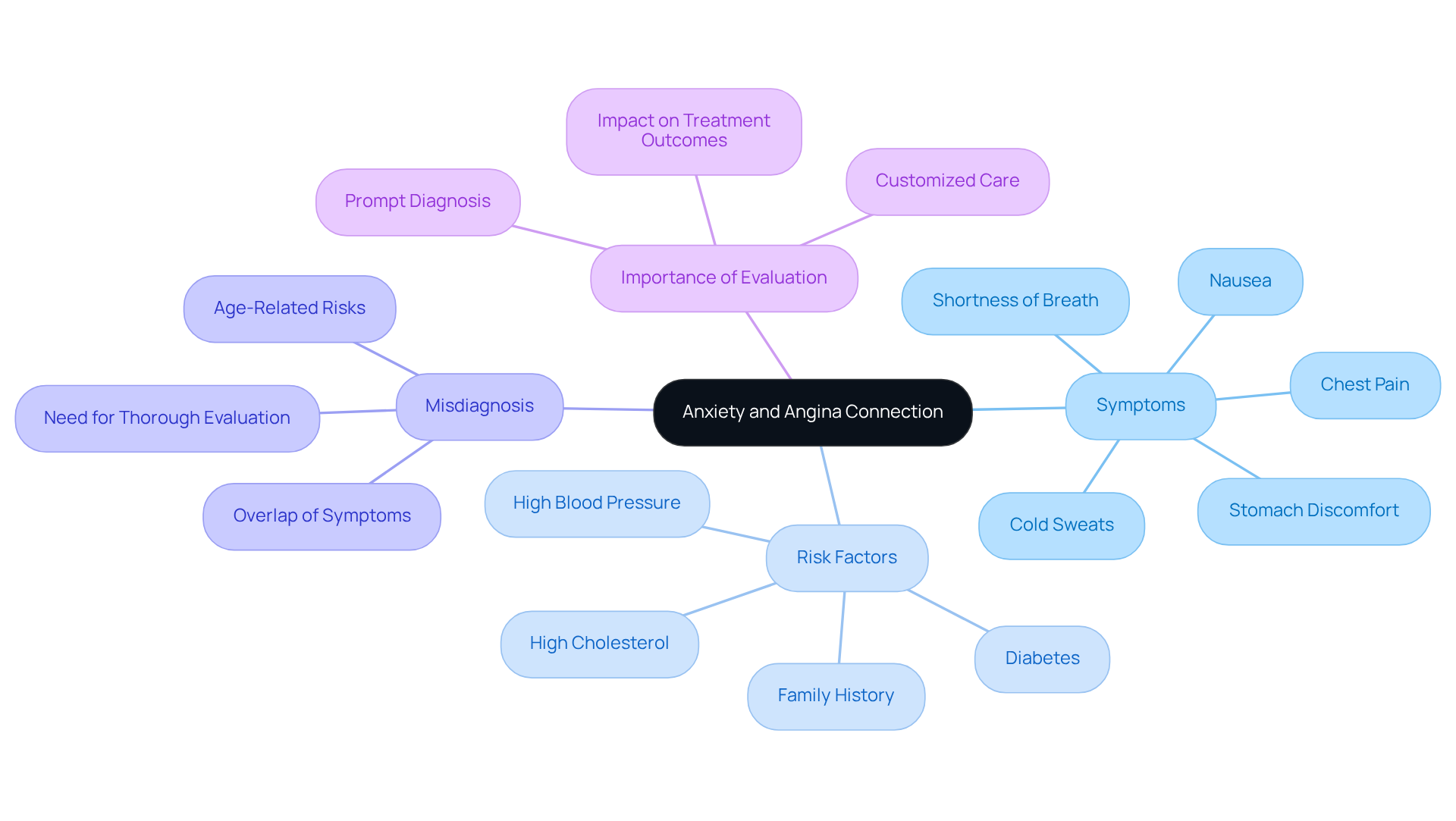
Experiencing signs of angina during physical activity, such as chest pain or shortness of breath, can be concerning and may indicate unstable heart conditions. This issue can arise even with minimal exertion, which is particularly alarming for older adults. Recent studies reveal that about 30% of older adults face unstable chest pain, highlighting their vulnerability to this serious condition that can escalate quickly and requires immediate attention.
At Amavita Heart and Vascular Health®, we prioritize your well-being through comprehensive cardiac evaluations and preventive strategies tailored to effectively address these risks. Caregivers play a crucial role in recognizing these signs. It's essential for them to encourage individuals to share any discomfort experienced during exercise, as it may necessitate urgent medical assessment.
Cardiologists emphasize the importance of being vigilant about the signs of angina. Dr. Judith Hochman emphasizes, "Timely intervention can significantly improve outcomes for seniors experiencing unstable angina." Understanding the prevalence of this condition among older adults is vital, as it underscores the need for heightened awareness and proactive management of cardiovascular health.
To ensure safety, caregivers should:
Furthermore, our groundbreaking AI-driven diagnostic technology enhances early detection, enabling informed choices and personalized cardiac care tailored to each individual's specific needs. We are here to support you every step of the way.
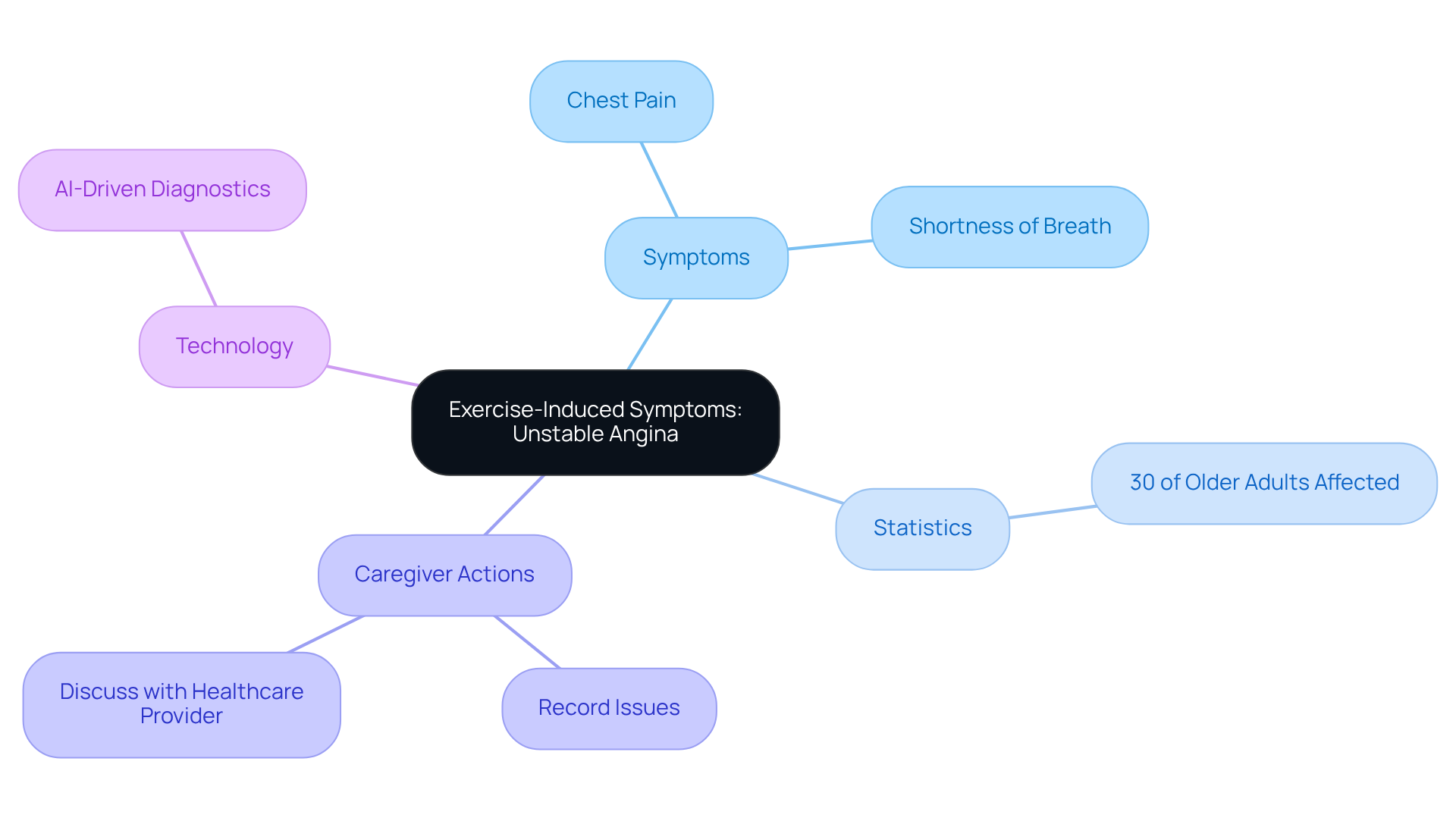
Changes in the pattern, frequency, or severity of chest pain can be considered signs of angina and are serious, requiring prompt attention, especially for older patients. Have you noticed an increase in the severity of your chest pain or the emergence of new symptoms such as dyspnea, fatigue, or signs of angina? It's important to recognize the signs of angina. Research shows that around 70% of adults over 75 years old live with multiple chronic conditions, which can complicate the presentation of angina.
Caregivers play a crucial role in observing these changes. They should encourage individuals to seek medical advice without delay. At Amavita Heart and Vascular Health®, we provide comprehensive cardiac evaluations that assess risk factors and develop personalized strategies. These include lifestyle modifications and preventive procedures aimed at reducing the risk of heart attacks.
Identifying changes in chest pain is vital, as these changes may present signs of angina and indicate a decline in one’s condition. For instance, Stephen Brecker, M.D., emphasizes that signs of angina, like heaviness or tightness in the chest, which are often described as a constricting sensation, should never be overlooked.
With our advanced AI-driven diagnostic technology, we enhance early identification and improve outcomes for individuals. By being attentive to changes in chest pain, timely interventions can be made, ultimately benefiting seniors with coronary artery disease. Remember, you are not alone in this journey, and we are here to support you every step of the way.
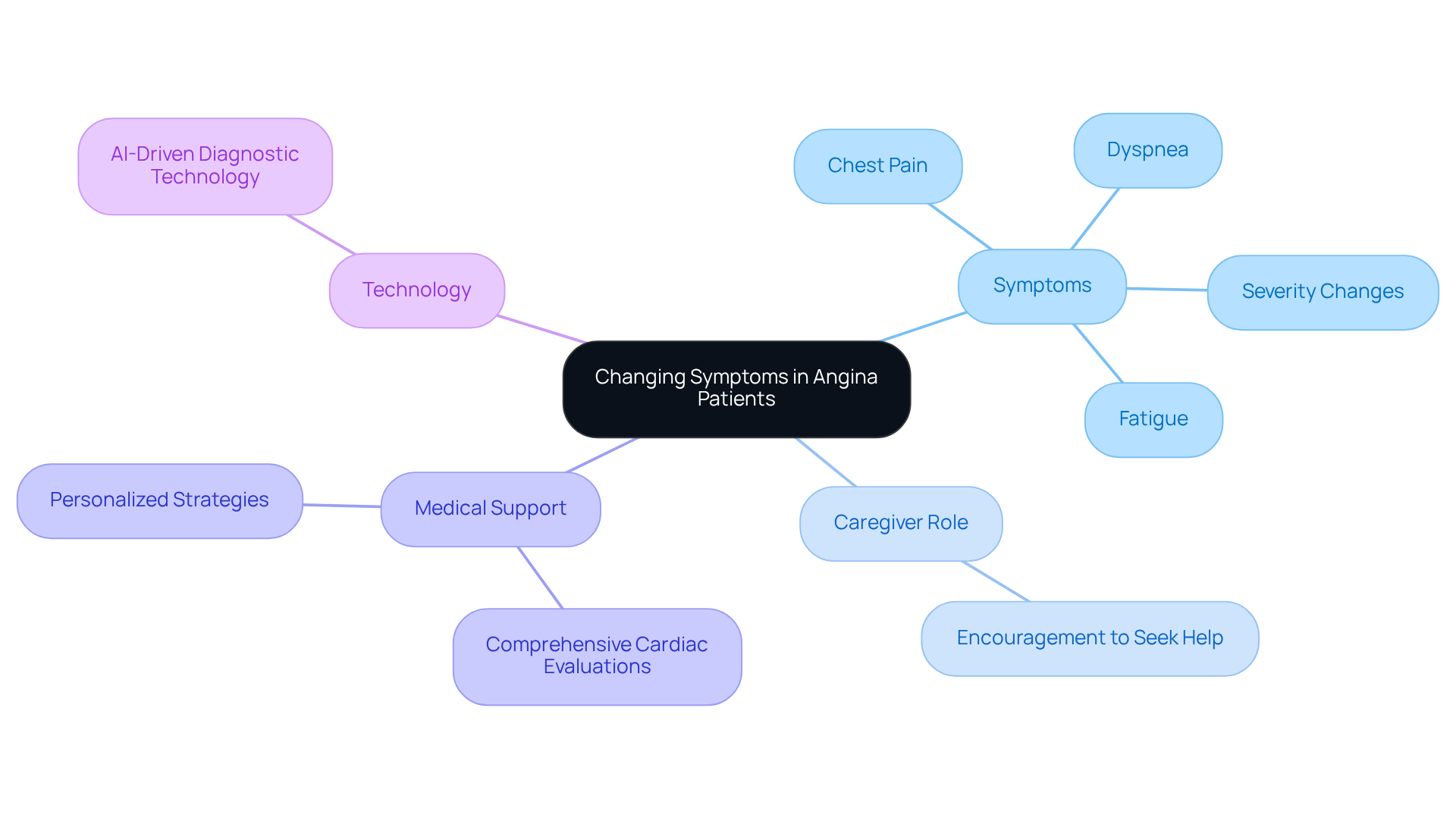
Severe signs of angina, including prolonged chest pain, intense shortness of breath, and discomfort that persists despite rest or medication, are indeed concerning and necessitate immediate medical attention. For elderly patients experiencing these symptoms, the risk for adverse cardiac events is notably higher, with many facing coronary risk factors like:
At Amavita Heart and Vascular Health®, we deeply understand the importance of comprehensive cardiac evaluations and preventive strategies. Lifestyle modifications and preventive procedures can significantly reduce the risk of a heart attack.
Caregivers, you play a vital role in this scenario. It’s crucial to be trained to recognize the signs of angina and respond promptly. Emergency medicine specialists remind us that new or worsening symptoms may signal a heart attack, necessitating immediate medical attention. Additionally, discomfort from unstable angina may also manifest in the teeth, jaw, neck, or back. By acting quickly, caregivers can make a profound difference in outcomes and potentially save lives. After all, a life is lost every 34 seconds due to heart disease.
Our innovative AI-powered diagnostic technology, including the Amavita CardioElite™ program, enhances early detection, empowering informed decisions and timely interventions. Together, we can navigate these challenges with compassion and expertise, ensuring that you and your loved ones receive the care and support you deserve.

Recognizing the signs of angina is crucial, especially for elderly patients who may present with atypical symptoms. Understanding these indicators can be the key to timely intervention and improved health outcomes. Awareness surrounding angina symptoms is essential, as early detection can significantly reduce the risk of severe complications, including heart attacks, which are prevalent in older adults.
Various signs of angina can manifest, including:
Caregivers play a vital role in monitoring these signs, as many elderly individuals may not express their discomfort clearly. Vigilance is necessary, particularly in recognizing changes in symptom patterns or the emergence of new symptoms, which can indicate a worsening condition requiring immediate medical attention.
Ultimately, understanding and recognizing the signs of angina can enhance the quality of care for elderly patients and empower caregivers to take proactive steps in seeking medical evaluation. Prioritizing heart health is essential, as timely intervention can lead to better management of cardiovascular conditions. By fostering awareness and encouraging open communication about symptoms, individuals and their caregivers can work together to navigate the complexities of heart health, ensuring that no one faces these challenges alone.
What is angina, and why is it important to recognize its symptoms early?
Angina is a common indicator of coronary artery disease (CAD) that manifests as chest pain, pressure, or discomfort, which may radiate to the jaw, neck, or back. Early recognition of angina symptoms is crucial, especially for elderly patients, as it allows for prompt treatment and significantly reduces the risk of serious complications, including heart attacks.
What are the typical symptoms of angina?
Typical symptoms of angina include chest pain, pressure, or discomfort. However, in elderly patients, these symptoms may present differently, potentially being less intense or even absent. Women may experience atypical symptoms such as nausea or shortness of breath.
How can caregivers help in recognizing angina symptoms in elderly patients?
Caregivers should be observant of any changes in behavior or activity levels in elderly patients that could indicate underlying discomfort. They should monitor for signs of chest pain or shortness of breath, even if the patient does not explicitly mention them, as these could signify angina.
What role does shortness of breath play in identifying angina?
Shortness of breath, or dyspnea, is an important warning sign of angina, sometimes occurring even at rest. It indicates that the heart may not be receiving enough oxygen, and up to 50% of older adults with coronary artery disease experience significant breathlessness during daily activities.
What are the potential consequences of untreated angina symptoms?
Untreated angina symptoms can lead to more serious cardiovascular issues, including heart attacks. Early detection and intervention are vital to managing angina effectively and improving the quality of life for those affected.
What management strategies are recommended for angina in older populations?
Effective management of angina in older populations often involves lifestyle changes, medication, and consistent monitoring. Prioritizing early detection and intervention can significantly improve health outcomes.
How can individuals and caregivers seek help if they recognize signs of angina?
If you or a loved one is experiencing symptoms of angina, it is important to reach out for medical help. There are resources available to assist you, and support is provided every step of the way.